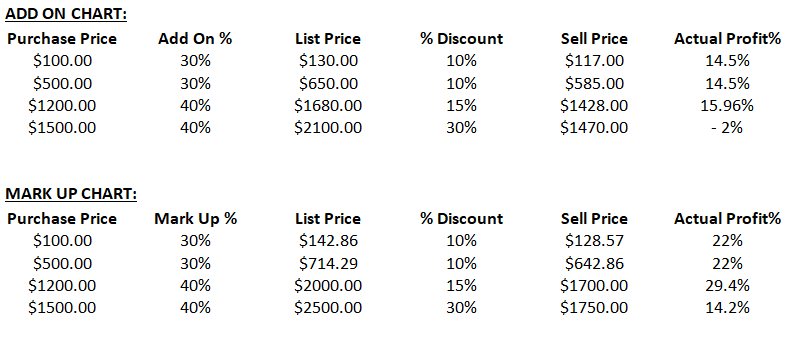Having a new sales person, after never having one, is a learning experience. Hiring someone without knowledge of the industry has its own challenges. Learning the products and services that are sold, and the combinations of both, can be a long process.
A common process that we have, that many other industries don’t, is that we sell products marked up from the net price, and hence don’t have a true list price. To my surprise many people, whether technicians, salespeople, or administrators don’t understand how to correctly mark a product up.
There are two methods that can be used to get your list price. The Percentage Add On, and the Percentage Mark Up. Most people use some form of Percentage Add On to create their list price, however to truly control your profitability a Percentage Mark Up should be used instead.
To show the difference between these two methods I will give several examples.
I will be using the following values to determine the selling price:
A Part Purchased for: $500
The desired Profit: 25%
Where S = Sell price, P = Purchase Price, Y = Desired Profit
PERCENTAGE ADD ON FORMULA
S = P + (P x Y)
$625 = 500 + (500 x 25%) or 500 +125
PERCENTAGE MARK UP FORMULA
S = P ÷ ( 1 – Y )
$666.67 = 500 ÷ (1 – 25%) or 500 ÷ 0.75
An Add On just adds a percentage to a known value and is easy to do, but it doesn’t work backwards. Using the Percentage Add On example above I get a selling price of $625. But what happens when I try to take 25% back out of the $625 -- $625 x 25%. I end up with a funny number that doesn’t match my add on, $156.25. With a Mark Up this doesn’t happen because you are actually increasing the purchase price by the selected percentage. Using the Mark Up example above I get a selling price of $666.67. I take out the 25% -- $666.67 x 25% and get $166.67 the exact amount added to my purchase price.
As prices and percentages go up the difference between an Add On and a Mark Up increase substantially. For example Marking Up $100 by 40% will give a sell price of $166.67 where an Add On gives $140. Now try it with $3000: Mark Up = $5000 Add On = $4200.
Setting your list prices using a percentage Add On will cause problems if you ever try to discount. Examine the following chart to see the problems that can occur.
A common process that we have, that many other industries don’t, is that we sell products marked up from the net price, and hence don’t have a true list price. To my surprise many people, whether technicians, salespeople, or administrators don’t understand how to correctly mark a product up.
There are two methods that can be used to get your list price. The Percentage Add On, and the Percentage Mark Up. Most people use some form of Percentage Add On to create their list price, however to truly control your profitability a Percentage Mark Up should be used instead.
To show the difference between these two methods I will give several examples.
I will be using the following values to determine the selling price:
A Part Purchased for: $500
The desired Profit: 25%
Where S = Sell price, P = Purchase Price, Y = Desired Profit
PERCENTAGE ADD ON FORMULA
S = P + (P x Y)
$625 = 500 + (500 x 25%) or 500 +125
PERCENTAGE MARK UP FORMULA
S = P ÷ ( 1 – Y )
$666.67 = 500 ÷ (1 – 25%) or 500 ÷ 0.75
An Add On just adds a percentage to a known value and is easy to do, but it doesn’t work backwards. Using the Percentage Add On example above I get a selling price of $625. But what happens when I try to take 25% back out of the $625 -- $625 x 25%. I end up with a funny number that doesn’t match my add on, $156.25. With a Mark Up this doesn’t happen because you are actually increasing the purchase price by the selected percentage. Using the Mark Up example above I get a selling price of $666.67. I take out the 25% -- $666.67 x 25% and get $166.67 the exact amount added to my purchase price.
As prices and percentages go up the difference between an Add On and a Mark Up increase substantially. For example Marking Up $100 by 40% will give a sell price of $166.67 where an Add On gives $140. Now try it with $3000: Mark Up = $5000 Add On = $4200.
Setting your list prices using a percentage Add On will cause problems if you ever try to discount. Examine the following chart to see the problems that can occur.


 RSS Feed
RSS Feed